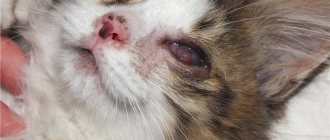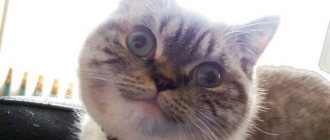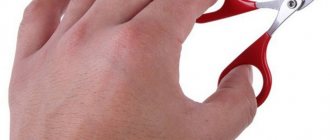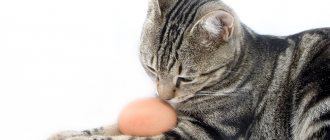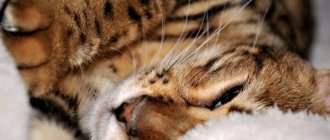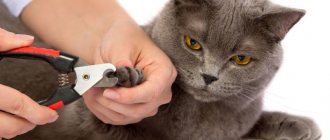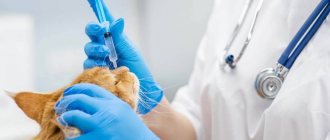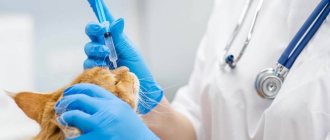Cats rarely experience panting, and sometimes your panting cat may be suffering from a serious illness. Therefore, to determine how to act if your cat is panting, it is quintessential that you first know all the reasons.
Cats pant due to overheating, playing in a warm environment for a long time, or due to stress. Other serious reasons why your cat is panting include early signs of diseases such as asthma, respiratory infection, heartworm, or even congestive heart failure.
Panting in cats is not common and you should immediately look out for signs that are causing panting and contact your veterinarian if necessary. Below we will discuss the main causes of panting in cats and other factors associated with panting.
Diagnostics
Having studied the external symptoms of cough, we proceed to diagnosis:
- conduct an external examination of the body, listen for wheezing and noises;
- evaluate cardiac activity;
- take blood for analysis;
- do an X-ray examination of the sternum;
- a culture of secretions or sputum is collected to identify the causative agent of inflammation;
- examine the affected organ for oncology (if suspected).
In clinics, it is possible to examine the entire animal’s body by different specialists and conduct an X-ray examination with a contrast agent.
The cat is choking and wheezing: what to do
Seizures in a cat: causes, what to do, treatment
You need to open the mouth and pull the tongue forward, check the throat for foreign objects that should be removed, including mucus or vomit. This will help clear your airways. To do this, hold the cat by its hind legs and raise its head.
Important! If you suspect a spinal injury, you should not lift or move the animal.
Read also: Mother insults sons
If removal of the foreign body does not help, you must begin first aid.
First aid for respiratory arrest
Step-by-step instruction:
How to give artificial respiration to a cat
- Start artificial respiration: lay the cat on its side, pull the tongue forward, cover the mouth with your hand and straighten the neck. Air is inhaled through the cat's nose every 3 seconds. It is important that the chest rises, but does not arch from excess inhaled air.
- During artificial respiration, you need to check for a heartbeat. If the heart is beating but there is no breathing, you need to inhale air at a rate of 10 breaths per minute until the cat breathes on its own.
- If you are completely sure of cardiac arrest, begin chest massage.
- If respiratory arrest is detected and resuscitation begins, it is important that someone call a veterinarian or take the cat and its owner to the clinic.
Important! Cardiopulmonary resuscitation should not be performed if the cat is conscious.
Instructions on how to perform chest compressions on a cat
Features of the respiratory system of kittens
The respiratory system of a kitten is not too different from a human:
1. Inhalation: the lungs inflate, due to which air is drawn through the nose, where it is warmed and filtered, passes through the pharynx into the larynx, from there into the trachea, then into the bronchi and lungs.
2. From the lungs, oxygen enters the blood and is distributed throughout the cells of the whole body.
3. Exhale: the diaphragm relaxes, nitrogen, oxygen and carbon dioxide are removed from the bronchi.
In addition to supplying the blood with oxygen, breathing performs the function of thermoregulation by removing excess fluid.
The respiratory rate of adults is on average 30 inhalations and exhalations per minute, in kittens it is approximately 40-50. Moreover, this indicator is approximate and unstable; it depends on many factors, both the environment and the internal state of the animal.
How to provide first aid to a choking pet
First aid methods depend on the cause of the illness. In case of short-term disturbance, breathing often normalizes on its own, but in case of long-term disturbance, followed by cardiac arrest, the animal may require artificial respiration and indirect massage.
Basic steps
For physiological reasons, the pet simply needs to be given time to catch its breath and calm down. If overheating is to blame, be sure to offer a bowl of water and cool the areas where large vessels pass (neck, inner thighs, groin) with a cold compress. It is also recommended to open all doors and windows to create a draft.
If the cat is breathing heavily and wheezing, carefully examine his throat and check the integrity of the ribs. If you find a foreign body or injury, go to the veterinary clinic immediately. Self-help can result in accidentally pushing the found bone or other object even deeper, so it’s better not to take risks here.
Thus, the main actions are limited to normalizing body temperature, ventilating the room and calming the animal. The only exception is sudden cardiac arrest, as well as poisoning, provided its cause is known.
Is it possible to do artificial respiration?
If a cat loses consciousness and does not respond to light, then it requires urgent resuscitation. The rescue operation must begin within 2-3 minutes after the heart has stopped. In such a critical situation, it is very important not to panic, immediately call a veterinarian at home, and then strictly follow the following algorithm:
- Place the animal on its right side and extend its neck in line with the body. This will facilitate air flow.
- Clean the oral cavity from accumulated secretions with a napkin or gauze and close the mouth tightly. Removing mucus will help your pet avoid choking once breathing returns to normal.
- Inhale more air, place your curled palm on the cat’s nose and gently exhale into his nostrils. The frequency of inhalations depends on the size of the animal. With average settings, 20 times per minute is enough. The kitten will need more frequent but less intense repetitions.
- Check your pulse every 20 seconds. When breathing stops, the heart temporarily continues its work, so indirect massage is not required in all cases. If the heartbeat has really stopped, move on to the next step.
- Place one hand on the cat's chest, holding it between the thumb and the other four fingers.
- Perform several quick and rhythmic pressing movements with a break of 5 seconds, remembering to alternate them with artificial respiration. For every 30 movements there should be 2 breaths.
If possible, the rescue operation is best carried out in pairs. Once the heartbeat resumes, the animal cannot be moved, so at this point you just need to wait for the veterinarian.
Stress and psycho-emotional reasons
As a rule, stress and psycho-emotional reasons in cats do not often lead to breathing problems. But this statement is only partly true. There are several breeds of cats that are characterized by an overly emotional disposition and even some odd behavior:
- Persian cats.
- Siamese and crossbred animals based on them.
- “Good-natured giants”, Maine Coons, can be very aggressive.
Some representatives of these breeds are characterized by short-term (and sometimes not very short) outbursts of anger. In this case, the cat may lose control of itself, breathe hoarsely and quickly, and meow loudly and protractedly. Trying to calm him down costs yourself more. If this happens constantly, you need to consult a veterinarian about prescribing sedatives and medications to correct the animal’s behavior.
First aid
In addition to the above private signs, the cat owner’s anxiety and concern should be caused by the following symptoms, common to all conditions that threaten the pet’s life:
- the cat is apathetic and lethargic;
- frequent vomiting;
- cough is dry or with bloody sputum;
- the cat shows signs of anxiety and fear.
If these symptoms are present in addition to difficulty breathing, the most effective help for your pet will be to take him to the clinic as soon as possible or call a doctor at home. During transportation or while waiting for help, the cat should be placed on its side and, if possible, its mobility should be limited.
It should be remembered that you cannot hesitate and waste time. Prolonged hypoxia entails irreversible changes in the brain, which will lead to the death of the pet.
Heart problems
Many people do not know what to do if a cat coughs and wheezes, for what reason this reflex occurs. A serious reason to see a doctor is the occurrence of heart problems. Most often, this disease occurs in old and overweight animals. At first, coughing rarely bothers the animal, but later it inevitably becomes more frequent.
The disease is diagnosed by tactile and visual examination. The pet's blood pressure is measured, electrocardiography and radiography are performed. Such a disease requires lifelong care for the animal and maintenance therapy. Treatment is prescribed by a veterinarian based on the research results obtained. Giving medications at your own discretion is strictly prohibited.
The cat must be provided with rest, proper nutrition and follow the doctor's instructions. For animals with this pathology, special dietary foods are sold in pharmacies.
Why is a cat breathing heavily and frequently: non-dangerous reasons
Tachypnea, or rapid, heavy breathing, occurs in a cat when there is a lack of oxygen, or hypoxia. This condition is explained by 2 reasons: physiological and pathological.
Physiological causes are not life-threatening. These include various external and internal factors:
- Heat. A pet can overheat outside on a hot day or in a stuffy room with poor ventilation.
- Eating food quickly. Characteristic in the absence of saturation and prolonged fasting. Due to the too rapid absorption of food, breaths are taken in fits and starts, so the oxygen supplied with them is not enough.
- Fatigue after high physical activity. When performing intense movements, muscles require more oxygen, which is why shortness of breath often occurs while running.
- Overexcitement due to fear or aggression. In a state of stress, the body actively produces adrenaline, which speeds up the heart and the frequency of breathing. After calming down, the alarming symptoms disappear on their own.
- Hormonal changes. Occurs during estrus, pregnancy and childbirth. Treatment in these cases is not required, provided that the rest of the condition remains normal.
The risk group includes older cats and overweight cats. They get tired faster and often suffer from obesity due to inactivity.
Which vaccine dose is more difficult to tolerate?
Sputnik is a two-stage vaccine. The first injection of the vaccine causes an unstable immune reaction, and the second dose consolidates the result. This method of administration increases the effectiveness of the vaccine and the duration of the body's protection. The interval between vaccines should be 21 days or slightly more. A deviation of several days (in one direction or another) does not pose a danger.
It is believed that younger and healthier patients respond more strongly to the vaccine, but there is no official data. Adverse effects the second time may be stronger than after the first dose, or they may be weaker. This is a normal reaction and may be associated with another type of adenovirus.
Typically, older people tolerate vaccination better than younger people. The risk of such an undesirable phenomenon as elevated body temperature decreases significantly with age.
Causes of wheezing
There are many factors why a cat coughs. Among the main ones are allergic reactions, foreign bodies in the respiratory tract, bronchial asthma, helminths, inflammatory processes in the lungs, viruses and heart disease.
An allergic reaction in a cat occurs when an irritant enters the respiratory tract. Allergies can be caused by household dust, chemicals (detergents, aerosols, tray fillers), low-quality dry food and chemicals used for repairs.
Some cats suffer from allergies caused by seasonal flowering plants. Cough also occurs in cats whose owners smoke. When the animal breathes, gurgling and wheezing sounds can be heard.
Another cause of coughing in a cat is foreign objects stuck in the throat or nasal passages. These can be small bones and objects, as well as trichobezoars (balls of hair). In this case, the cat coughs and wheezes, trying to clear its throat and get rid of the irritating object.
Bronchial asthma is a dangerous condition of the animal’s body, the symptom of which is a strong, lingering cough and a general deterioration in the pet’s condition. Asthma is often associated with a genetic predisposition and can occur as a result of common allergies.
Cough can also be caused by helminthiasis. This is one of the most commonly diagnosed causes of animal cough.
Cat owners mistakenly believe that parasites exclusively affect the intestinal tract. In fact, lungworms are much more dangerous and often fatal, affecting the animal's respiratory system.
During breathing, the cat can hear wheezing, provoked by increased mucus production to quickly get rid of cysthelminths.
Pneumonia is a disease that affects the lower parts of the respiratory system. It usually occurs against the background of bacterial and viral infections of the respiratory tract, rarely developing independently. In addition to coughing, the animal experiences breathing disturbances, a large amount of sputum and mucus produced, a deterioration in the animal’s general condition and an increase in body temperature.
The cause of a specific reaction of the body in the form of a cough can be all kinds of viral infections that affect the nose, pharynx, bronchial tree and lungs. The most dangerous are viral rhinotracheitis and calcivirosis. In addition to coughing, the cat is diagnosed with apathy, depression of general condition and refusal to eat. Viral infections are often accompanied by an increase in body temperature to high levels.
Diseases of the heart muscle that provoke coughing are rarely diagnosed in domestic cats. If there is a disturbance in the functioning of the heart, the visible mucous membranes become cyanotic, shortness of breath and depression of the general condition are observed.
The owner of a mustachioed pet should carefully monitor the nature and strength of the cough, noting other accompanying symptoms. It is not recommended to self-medicate, since without an accurate diagnosis it is not possible to make a diagnosis and prescribe treatment. Moreover, by delaying a visit to a specialist, the owner only makes things worse. Especially when it comes to foreign bodies stuck in the respiratory tract, because the animal can die.
Undesirable effects of other Russian vaccines
"CoviVac"
This is an inactivated vaccine. That is, a killed coronavirus is delivered to the body. This is an old and proven technology, many vaccines against viral diseases have been made using it: polio, influenza and others. Dead viruses cannot cause disease, but their entry is enough for the body to learn to recognize them. As a result, when a live virus enters from an infected person, a strong immune response is formed immediately.
To enhance the immune response, aluminum hydroxide was added to CoviVac. One dose contains up to 0.5 mg. This dose is much less than permissible.
The instructions for the drug say that the vaccine can rarely cause headaches and short-term fever. Pain and hardness at the injection site are more common.
"EpiVacCorona"
This vaccine differs from Sputnik V and CoviVac in that it is not created using viruses. It is not killed or neutralized virus particles that are introduced into the body, but artificially created proteins. Using them, the immune system is trained to recognize real viruses. This method of creation reduces the reactogenicity of the vaccine, so it is recommended for vaccination in elderly or weakened people.
In a publication in the Russian journal Infection and Immunity, the vaccine developers claim that the only adverse events were mild pain at the injection site. And the CoviVac vaccine does not cause headaches, muscle weakness and other common symptoms.
Types of cough
Just like in humans, a cat’s cough is characterized by several criteria, thus being divided into types:
By duration:
- Chronic – lasts for months;
- acute – lasts several days.
By the nature of the discharge:
- wet;
- dry.
By volume:
- muted;
- weak;
- voiced.
By intensity:
- easy;
- hysterical, leading to vomiting.
By time of day:
- morning;
- evening.
By season:
- spring;
- autumn, etc.
When you observe your pet's cough, try to determine its type based on these parameters, so that you can then provide the doctor with a complete picture of the disease. Also pay attention to the time of day at which the cough peaks.
Helping a cat with choking
If your cat is choking, you should see a veterinarian as soon as possible. If it is not possible to show the animal to a specialist, try to quickly remove the object from the animal’s throat/mouth yourself (except for needles and sharp objects - only a veterinarian can remove them!). Be careful and attentive, as in this state the cat experiences panic and may become aggressive.
Secure your pet and place the index finger and thumb of one hand on his upper lip, pressing it against his jaw. With your other hand, open the cat's mouth. Gently pull on the tongue to examine the throat and mouth. Try removing the foreign object with tweezers. If something is stuck in the throat or esophagus, you can remove it by inducing vomiting in the cat (only if the animal has swallowed a non-sharp object!). Give him a teaspoon of water salted with ¼ teaspoon salt.
Vaseline oil will help you deal with a small foreign object (a blade of grass, a hair): pour 1 teaspoon of this liquid into the cat’s mouth. Vegetable oil can help remove a foreign object or at least move it into the stomach (give the cat 2-3 teaspoons).
If none of the above methods help, try the following: spread your legs wide, turn the cat upside down and shake vigorously. If there is no positive result, place the pet on its side, place your palms on the sides of its body behind the last ribs. Press sharply on the sides with your hands several times - the object should jump out of the animal’s mouth.
Signs of suffocation and foreign objects in the mouth
The following signs may indicate that a cat has a foreign object stuck in its throat:
- persistent cough;
- the cat salivates profusely;
- the pet is choking, suffocating.
If you notice these signs in your cat, check his mouth - there may be a foreign object there. If the pet is not given help, it may die from suffocation, which is accompanied by the following symptoms:
- cough and wheezing;
- the pet's eyes pop out of their sockets;
- the tongue and gums turn blue;
- the animal tries to put its paw into its mouth;
- loss of consciousness.
How to provide help at home?
With rhinotracheitis, cats do not stay in the clinic, but are sent home with the owner. To prevent your pet’s condition from worsening, carefully follow all the veterinarian’s recommendations. Under no circumstances treat a cat’s cough with “human” drugs to thin the sputum - this is very dangerous for the pet’s health.
In cases where a cat's eyes are affected by rhinotracheitis, it is prohibited to use any drops!
At home, it is necessary to provide the animal with:
- drinking plenty of water,
- balanced high-calorie diet,
- a cozy and warm place to relax,
- peace and quiet.
If the cat completely refuses to eat, then contact the veterinarian again - this is necessary to put on an IV and avoid the development of complications.
Why fill out a vaccination diary at State Services?
You can register possible adverse events on the government services website. This is necessary in order to collect as many statistics as possible and draw broader conclusions about the safety of the vaccine. This is especially important if the administration of the vaccine in a particular case is accompanied by serious adverse reactions.
In most cases, adverse events from vaccination go away within a short time without harm, unlike coronavirus infection. So far, there have been no serious complications or deaths reliably linked to Sputnik V or other Russian vaccines.
When should I worry?
Your cat's wheezing breathing is nothing to worry about. However, it is important to consult a veterinarian to determine the cause of this condition and provide treatment if necessary.
If you see any of the following symptoms along with wheezing, contact your veterinarian immediately.
- Having difficulty catching my breath
- Cough or choking
- Very pale or bluish gums
- Dripping/collection of mucus in the mouth
- Signs of distress (asthma attack)
- Prolonged wheezing
- Very lethargic
When to see a doctor
After vaccination, it is better to wait half an hour rather than leave immediately. This is necessary to make sure there is no allergic reaction. If it becomes difficult to breathe, there is a feeling of a strong heartbeat, tinnitus, rash, dizziness, or swelling of the face begins, you need to contact the vaccination center for medical help.
You should also consult a doctor if after vaccination:
- headache, weakness or fever does not go away within three to four days;
- high fever is not brought down by medications;
- Redness and thickening at the injection site increases on the second or third day.
Diagnosis of respiratory organs
Diagnostic methods in the clinic are aimed at identifying the causes of choking, coughing and shortness of breath and consist of:
- collecting anamnesis (finding out medical history). At this moment, the main role is assigned to the cat's owner. It is he who must tell about the signs, frequency, rhythm, strength of cough and shortness of breath, how long ago the first case was recorded, whether there is discharge and what other signs were recorded in the animal; • examination and palpation (oral and nasal cavity, trachea and esophagus, thoracic cells for integrity);
- auscultation (listening) of the bronchi and lungs;
- thermometry;
- if necessary, chest X-ray examination;
- performing endoscopy of the trachea;
- carrying out bacterial culture of nasal secretions for subtitration of microflora sensitivity to antibiotics;
- general blood analysis;
- blood chemistry;
- ultrasound examination of the chest cavity;
- analysis of fecal matter for worm eggs;
- thoracentesis (taking the contents of the chest cavity for examination).
Of all the listed diagnostic methods at home, you can carry out inspection, palpation, thermometry and auscultation. Often these methods are not sufficient to establish a diagnosis and prescribe treatment.
What will the veterinarian do if the kitten is breathing heavily?
When a kitten is seen by a veterinarian due to rapid breathing, specialists usually carry out the following procedures:
— Questioning the owner about the time when rapid breathing was noticed, the presence or absence of associated problems and possible natural causes.
— Visual examination of the animal, during which the doctor determines whether the body is dehydrated, what condition the mucous membranes are in, etc.
— Temperature measurement.
— Detection of helminthic infestation.
— Prescribing the necessary additional laboratory tests. For example, a blood test to rule out anemia or infectious diseases.
— Referral for an ultrasound or x-ray if there is a suspicion of heart disease or other internal organs.
— A puncture of the chest wall (thoracentesis), which allows you to determine whether there is excess air or fluid in the chest cavity. Used only in extreme cases.
How to treat wheezing breathing
Breathing with wheezing in a cat is treated in various ways and means. Depending on the type of disease, the doctor prescribes appropriate treatment.
Laryngeal edema is treated with medications that relieve swelling;
- — Brachiocephalic syndrome is usually eliminated surgically;
- — Pulmonary edema is relieved by intensive therapy, often requiring artificial ventilation;
- — Bronchitis is removed with antitussives;
- — Neoplasms and tumors are eliminated by chemotherapy (if amenable);
- — Foreign bodies are usually removed using an endoscope;
- — Laryngeal paralysis is eliminated through surgery.
The results of treatment if you go to the clinic in a timely manner are mostly positive.
Why does a cat have no voice?
The reasons why an animal lost its voice can be divided into three main groups:
- infectious diseases,
- non-communicable diseases,
- associated environmental factors.
One of the reasons for a cat’s loss of voice is infectious diseases of various etiologies: viral rhinotracheitis, infectious laryngitis, calcivirosis, rabies. With viral rhinotracheitis, the mucous membranes of the nose, throat and trachea are affected, which is accompanied by hoarseness or complete loss of voice in the sick animal. The causative agent of the disease is the herpes virus. Timely and proper treatment and dietary nutrition contribute to the rapid restoration of vocal function in a cat.
One of the common reasons why a cat has lost its voice is infectious laryngotracheitis, the causative agent of which belongs to the herpesvirus family. The disease is accompanied by inflammatory processes in the upper respiratory tract and laryngeal edema. These phenomena lead to hoarseness of the animal, as well as a complete absence of voice.
It hurts the cat to eat, drink water and meow. Infectious laryngotracheitis is often a consequence of advanced influenza, sore throat, colds, and rhinitis.
With viral calcivirus, one of the symptoms of the disease is hoarseness and loss of voice in the animal. This viral disease poses a deadly threat to small kittens and older animals. Symptoms of the disease are respiratory in nature. A sick pet has a hoarse voice and complete loss of voice. Ulcers are observed on the mucous membrane of the oral cavity, on the tongue, and on the tip of the nose. In severe cases, pneumonia develops.
Viral calcivirus in a cat: multiple ulcers filled with fluid on the tongue and palate
Silence of an animal can occur as a result of a dangerous disease for humans - rabies. This rare and fatal disease causes the cat to lose his voice due to paralysis of the pharynx and larynx. The animal does not speak, refuses to eat, there is drooling, hydrophobia and photophobia. The most effective prevention of a dangerous disease is timely vaccination of your pet.
One of the non-infectious reasons why a cat is hoarse is otitis media. The inflammatory process that occurs in the animal's middle ear leads to the development of edema of the laryngeal mucosa. In this case, the cat or cat loses its vocal abilities until the voice completely disappears.
The cause of swelling of the larynx and, as a result, hoarseness and loss of voice, may be an allergy. Allergic edema reduces the lumen of the larynx, complicating the animal’s vocal abilities.
Hoarseness of the voice and its complete disappearance are often observed when the pet’s body is dehydrated. Your pet should have free access to water at all times.
It is especially important to fulfill this condition when feeding your cat dry food.
Very often, the reasons why a cat has lost his voice, does not meow, or the animal’s voice is changed are injuries to the larynx, foreign objects in the oral cavity. The most common injury to a cat's larynx occurs with fish bones or inedible sharp objects. As a result of the penetration of a foreign body into the larynx, mechanical damage to the mucous membrane occurs, which is accompanied by swelling, which impedes vocal function.
Factors leading to loss of voice in an animal include:
- Keeping an animal in a room where there is frequent smoking. Cigarette smoke contains high levels of irritating toxic substances that can cause laryngeal swelling in your pet. In this case, the cat often has a hoarse voice.
- The dryness of the air in a room or apartment, especially during the heating season, provokes irritation and dryness of the laryngeal mucosa, hoarseness, and sometimes leads to a complete loss of the cat’s voice.
- Respiratory poisoning of an animal by toxic fumes from paint coatings, organic solvents, and disinfectants. Spraying household aerosols, cosmetics (varnishes, deodorants, etc.) can also cause hoarseness in a cat.
- After anesthesia, the animal may become hoarse for a short period of time.
Tags
if a cat coughs a panting cat in a cat licking fur, this is a cat before If a cat is not an adult cat can If a cat is in a hurry about a dog about a dog Dog breeds Dog health Dog nutrition Dog training Dog health behind a dog Why is a dog afraid of Dogs in cats. cat deaths occur in cats and Cat breeds Cat health Cat nutrition Cat behavior Health cats in cats and in cats and
dogbreedrodentsarticlerespiratoryservicesopen questioncontentsurgeonanswervaccinationbirddepartment
